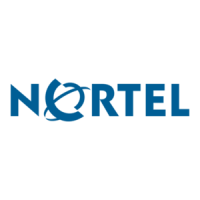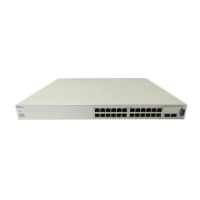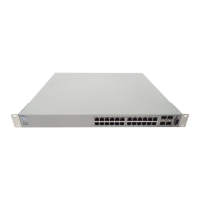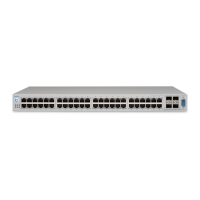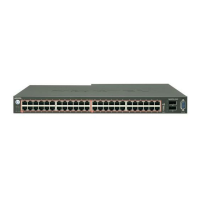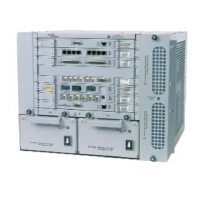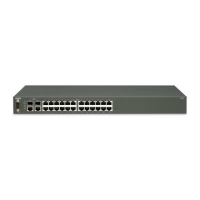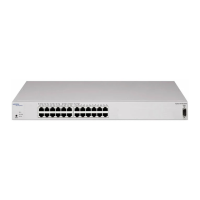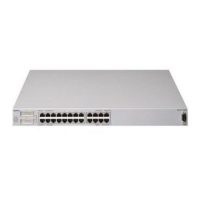Do you have a question about the Nortel 5530 and is the answer not in the manual?
Grouping of ports, capabilities, and classifications for policy application.
Identifying traffic flow using Layer 2 or IP content.
Actions like drop, update DSCP, meter, redirect.
Details limitations and capabilities of classification masks and classifiers.
Grouping classifiers to manage resources and improve efficiency.
Settings (regular, large, maximum) for buffer allocation.
Mapping 802.1p priority to egress queues and buffer allocation.
Configuring committed rate, burst rate, and actions.
Configuring shaping rate, burst rate, and duration on interfaces.
Overview of ACLs, their application, and limitations.
Commands to add IP ACLs with various criteria.
Commands to add Layer 2 ACLs with MAC, EtherType, VLAN criteria.
Building a binding table to secure DHCP messages.
Preventing MITM attacks by validating ARP packets.
Security against invalid source IP addresses using the DHCP binding table.
Preventing ARP spoofing attacks.
Solutions for DHCP spoofing and rogue DHCP server attacks.
Enabling various Denial of Service (DoS) QoS applications.
Dropping incoming BPDUs on specific interfaces.
Assigning ports to roles and interface classes.
Adding IP or L2 classifier elements and creating classifiers/blocks.
Adding meters with committed rate, burst rate, and actions.
Creating policies by assigning classifiers, blocks, and meters.
Overview of pre-defined QoS actions and IP element parameters.
Example of configuring traffic meters with policies.
Example of implementing multiple security features and ACLs.
Example of filtering based on port ranges.
Example of classifying traffic based on MAC address.
Example of classifying traffic based on L2 and L3 criteria.
Example of QoS marking using ACLs and role combinations.
Example of configuring interface shaping.
Grouping of ports, capabilities, and classifications for policy application.
Identifying traffic flow using Layer 2 or IP content.
Actions like drop, update DSCP, meter, redirect.
Details limitations and capabilities of classification masks and classifiers.
Grouping classifiers to manage resources and improve efficiency.
Settings (regular, large, maximum) for buffer allocation.
Mapping 802.1p priority to egress queues and buffer allocation.
Configuring committed rate, burst rate, and actions.
Configuring shaping rate, burst rate, and duration on interfaces.
Overview of ACLs, their application, and limitations.
Commands to add IP ACLs with various criteria.
Commands to add Layer 2 ACLs with MAC, EtherType, VLAN criteria.
Building a binding table to secure DHCP messages.
Preventing MITM attacks by validating ARP packets.
Security against invalid source IP addresses using the DHCP binding table.
Preventing ARP spoofing attacks.
Solutions for DHCP spoofing and rogue DHCP server attacks.
Enabling various Denial of Service (DoS) QoS applications.
Dropping incoming BPDUs on specific interfaces.
Assigning ports to roles and interface classes.
Adding IP or L2 classifier elements and creating classifiers/blocks.
Adding meters with committed rate, burst rate, and actions.
Creating policies by assigning classifiers, blocks, and meters.
Overview of pre-defined QoS actions and IP element parameters.
Example of configuring traffic meters with policies.
Example of implementing multiple security features and ACLs.
Example of filtering based on port ranges.
Example of classifying traffic based on MAC address.
Example of classifying traffic based on L2 and L3 criteria.
Example of QoS marking using ACLs and role combinations.
Example of configuring interface shaping.
| Model | 5530 |
|---|---|
| Type | Switch |
| Ports | 48 x 10/100/1000 |
| Power over Ethernet (PoE) | Yes |
| Switching Capacity | 176 Gbps |
| Forwarding Rate | 131 Mpps |
| Weight | 5.6 kg |
| Uplink Ports | 4 x 10 Gigabit Ethernet |
| MAC Address Table Size | 32000 entries |
| Jumbo Frame Support | 9 KB |
| Routing Protocol | RIP |
| Remote Management Protocol | RMON |
| Authentication Method | TACACS+ |
| Features | Quality of Service (QoS) |
| Compliant Standards | IEEE 802.3ab |
| Operating Temperature | 0 °C to 45 °C |
| Storage Temperature | -25 °C to 70 °C |
| Power Supply | AC 100-240 V |
| Dimensions (W x D x H) | 440 mm x 350 mm x 44 mm |

